Supply Chain Management
VerifiedAdded on 2023/06/04
|10
|3007
|488
AI Summary
This report discusses the importance of supply chain management in the automotive industry and how it can be improved using four essential imperatives. It also includes a well-constructed supply chain model for the industry.
Contribute Materials
Your contribution can guide someone’s learning journey. Share your
documents today.
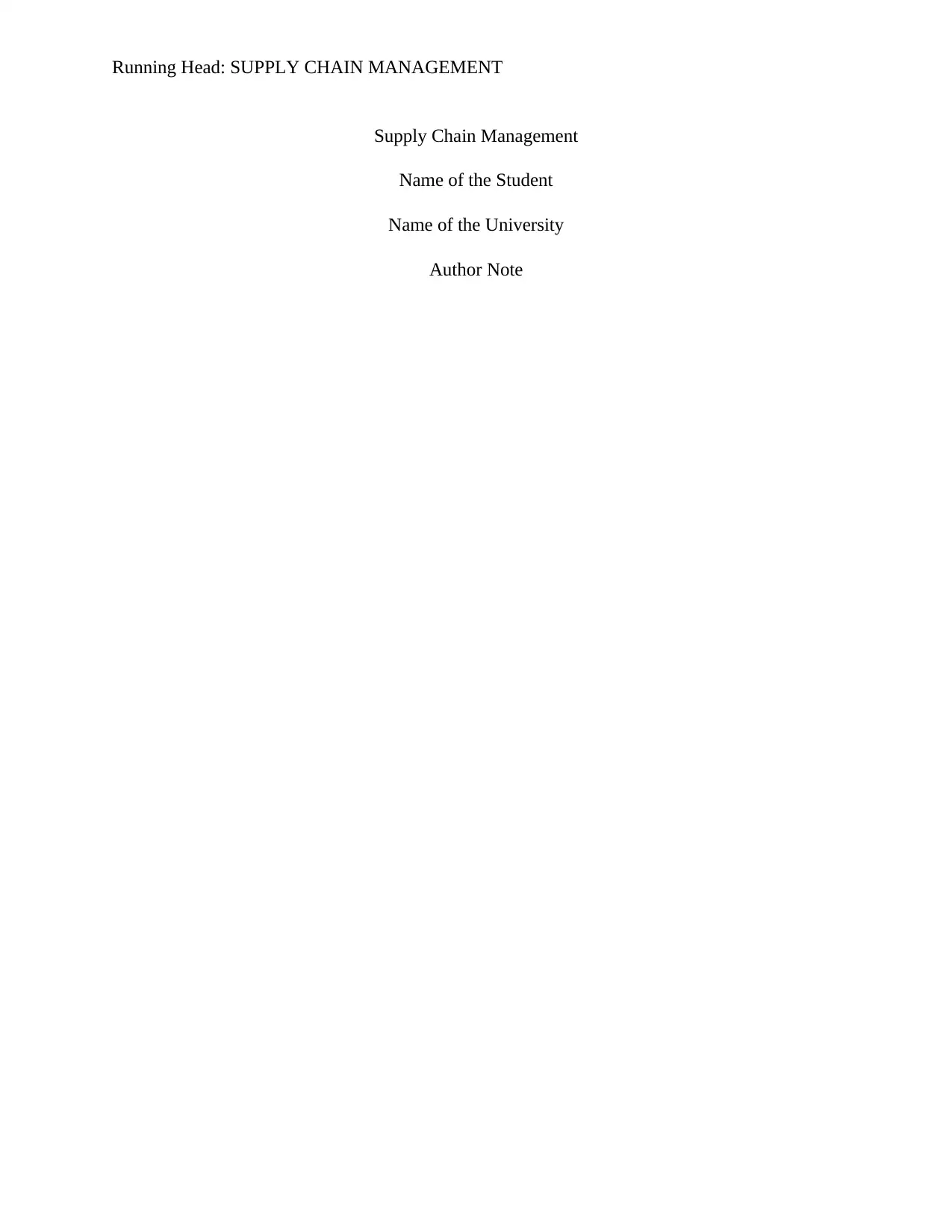
Running Head: SUPPLY CHAIN MANAGEMENT
Supply Chain Management
Name of the Student
Name of the University
Author Note
Supply Chain Management
Name of the Student
Name of the University
Author Note
Secure Best Marks with AI Grader
Need help grading? Try our AI Grader for instant feedback on your assignments.
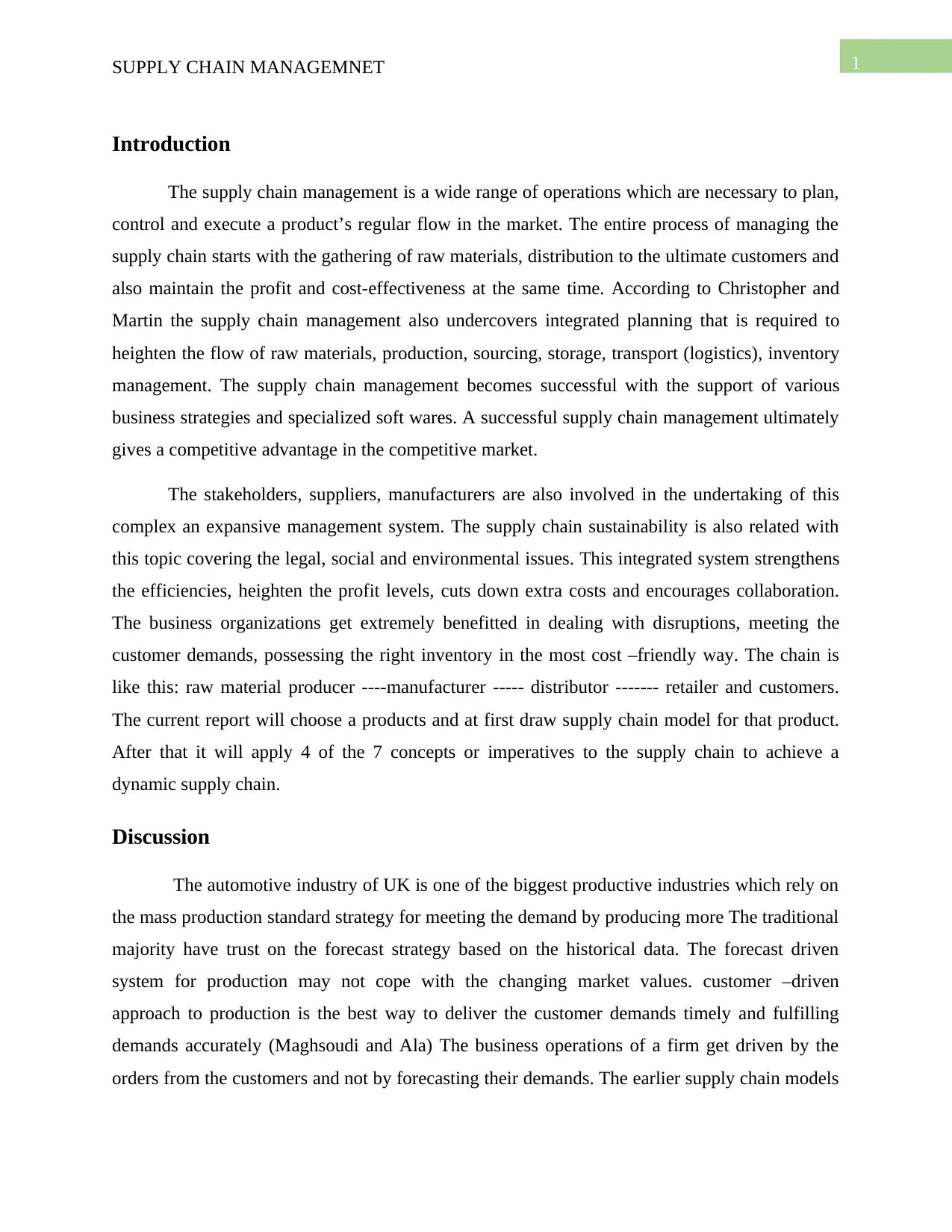
1SUPPLY CHAIN MANAGEMNET
Introduction
The supply chain management is a wide range of operations which are necessary to plan,
control and execute a product’s regular flow in the market. The entire process of managing the
supply chain starts with the gathering of raw materials, distribution to the ultimate customers and
also maintain the profit and cost-effectiveness at the same time. According to Christopher and
Martin the supply chain management also undercovers integrated planning that is required to
heighten the flow of raw materials, production, sourcing, storage, transport (logistics), inventory
management. The supply chain management becomes successful with the support of various
business strategies and specialized soft wares. A successful supply chain management ultimately
gives a competitive advantage in the competitive market.
The stakeholders, suppliers, manufacturers are also involved in the undertaking of this
complex an expansive management system. The supply chain sustainability is also related with
this topic covering the legal, social and environmental issues. This integrated system strengthens
the efficiencies, heighten the profit levels, cuts down extra costs and encourages collaboration.
The business organizations get extremely benefitted in dealing with disruptions, meeting the
customer demands, possessing the right inventory in the most cost –friendly way. The chain is
like this: raw material producer ----manufacturer ----- distributor ------- retailer and customers.
The current report will choose a products and at first draw supply chain model for that product.
After that it will apply 4 of the 7 concepts or imperatives to the supply chain to achieve a
dynamic supply chain.
Discussion
The automotive industry of UK is one of the biggest productive industries which rely on
the mass production standard strategy for meeting the demand by producing more The traditional
majority have trust on the forecast strategy based on the historical data. The forecast driven
system for production may not cope with the changing market values. customer –driven
approach to production is the best way to deliver the customer demands timely and fulfilling
demands accurately (Maghsoudi and Ala) The business operations of a firm get driven by the
orders from the customers and not by forecasting their demands. The earlier supply chain models
Introduction
The supply chain management is a wide range of operations which are necessary to plan,
control and execute a product’s regular flow in the market. The entire process of managing the
supply chain starts with the gathering of raw materials, distribution to the ultimate customers and
also maintain the profit and cost-effectiveness at the same time. According to Christopher and
Martin the supply chain management also undercovers integrated planning that is required to
heighten the flow of raw materials, production, sourcing, storage, transport (logistics), inventory
management. The supply chain management becomes successful with the support of various
business strategies and specialized soft wares. A successful supply chain management ultimately
gives a competitive advantage in the competitive market.
The stakeholders, suppliers, manufacturers are also involved in the undertaking of this
complex an expansive management system. The supply chain sustainability is also related with
this topic covering the legal, social and environmental issues. This integrated system strengthens
the efficiencies, heighten the profit levels, cuts down extra costs and encourages collaboration.
The business organizations get extremely benefitted in dealing with disruptions, meeting the
customer demands, possessing the right inventory in the most cost –friendly way. The chain is
like this: raw material producer ----manufacturer ----- distributor ------- retailer and customers.
The current report will choose a products and at first draw supply chain model for that product.
After that it will apply 4 of the 7 concepts or imperatives to the supply chain to achieve a
dynamic supply chain.
Discussion
The automotive industry of UK is one of the biggest productive industries which rely on
the mass production standard strategy for meeting the demand by producing more The traditional
majority have trust on the forecast strategy based on the historical data. The forecast driven
system for production may not cope with the changing market values. customer –driven
approach to production is the best way to deliver the customer demands timely and fulfilling
demands accurately (Maghsoudi and Ala) The business operations of a firm get driven by the
orders from the customers and not by forecasting their demands. The earlier supply chain models

2SUPPLY CHAIN MANAGEMNET
for the automotive industry revolved around manufacturing operations and supplier collaboration
but in the changed world the dynamics have also changed. In order to compete in the highly
competitive market the automotive industry needs to enhance the facilities, features and effort
(Azadi et al.). The automotive industry has been found to be forced into price and delivery tome
reduction related issues, customer service improvements and launch environment friendly
products. The automotive industry need to be more agile to customer’s responses, demands and
flexible to adopt any change that would fulfill the requirements of the customers and bring a
successful tomorrow.
An efficient supply chain model -
An automotive supply chain model for a demand –driven market will help to solve the
challenges that the automotive industry is facing. The model consists of three principle processes
including the physical flow, operational strategies and planning processes. The proposed model
will not be based on the forecast method and respond positively to the changing demands of the
customers. The model uses a demand –driven approach to ensure effectiveness in the supply
chain. Flexible manufacturing system and the strategy of lean supply chain accentuates the
efficiency of the supply chain. The automotive supply chain is an extremely complicated system
and comprised of a range of processes. These processes when linked together form a strong
supply chain. The major bodies of supply chain are the original equipment manufacturers, the
original equipment suppliers, the aftermarket and lastly the first, second and third tire component
manufacturers.
The physical flow of the supply chain – It involves the flow of processes and
information relating to the shift and movement of the physical goods in storage or transit. In this
part of the model the parts of the vehicles are transported to the assembly plant produced by the
suppliers and carried by the inbound logistics. In the assembly plan the vehicle undergoes the
body shop shifts to the paint shop to get painted, relocates to the assembly and finally goes
though the inspection process. After the product is manufactured, it gets transported to the
dealership though outbound logistics
The suppliers – According to the model, the suppliers are the base of the production.
They provide thousands of components that are used in the manufacturing of the vehicle and
transported from various tier-one suppliers all around the globe via outbound logistics. Although
for the automotive industry revolved around manufacturing operations and supplier collaboration
but in the changed world the dynamics have also changed. In order to compete in the highly
competitive market the automotive industry needs to enhance the facilities, features and effort
(Azadi et al.). The automotive industry has been found to be forced into price and delivery tome
reduction related issues, customer service improvements and launch environment friendly
products. The automotive industry need to be more agile to customer’s responses, demands and
flexible to adopt any change that would fulfill the requirements of the customers and bring a
successful tomorrow.
An efficient supply chain model -
An automotive supply chain model for a demand –driven market will help to solve the
challenges that the automotive industry is facing. The model consists of three principle processes
including the physical flow, operational strategies and planning processes. The proposed model
will not be based on the forecast method and respond positively to the changing demands of the
customers. The model uses a demand –driven approach to ensure effectiveness in the supply
chain. Flexible manufacturing system and the strategy of lean supply chain accentuates the
efficiency of the supply chain. The automotive supply chain is an extremely complicated system
and comprised of a range of processes. These processes when linked together form a strong
supply chain. The major bodies of supply chain are the original equipment manufacturers, the
original equipment suppliers, the aftermarket and lastly the first, second and third tire component
manufacturers.
The physical flow of the supply chain – It involves the flow of processes and
information relating to the shift and movement of the physical goods in storage or transit. In this
part of the model the parts of the vehicles are transported to the assembly plant produced by the
suppliers and carried by the inbound logistics. In the assembly plan the vehicle undergoes the
body shop shifts to the paint shop to get painted, relocates to the assembly and finally goes
though the inspection process. After the product is manufactured, it gets transported to the
dealership though outbound logistics
The suppliers – According to the model, the suppliers are the base of the production.
They provide thousands of components that are used in the manufacturing of the vehicle and
transported from various tier-one suppliers all around the globe via outbound logistics. Although

3SUPPLY CHAIN MANAGEMNET
it keeps the quality of the automobile parts intact, the entire process consumes huge time. The
entire assembly of the vehicle depend on the parts timely delivered. This problem can be solved
by establishing supplier parks and modularization strategies to reduce the lead –time. The
concept of supplier parks tells about the assembly, production, warehousing and sequencing
being run by a third party suppliers in some near about places bridging the issue of distance.
Inbound and outbound logistics- Since the logistics are the connecting bodies between
the system sin a supply chain, it is an inseparable part of the entire system. The two types of
logistics, inbound and outbound are responsible for the whole vehicle supply. The time period
from the manufacturing to distributing is truly short and the customers keep on asking when their
product will arrive. The assemblers are supposed to keep in hold excessive stocks if the right
inventory is not predicted by them, Hence, the supply chain needs super-active inbound logistics.
In the case of outbound logistics, the geographical distance of the end customers should also be
taken into consideration and managed properly with the supplier parks and idea of
modularization.
The operational and planning process in the supply chain model- A strategic
approach to operational process along with the physical processes form an efficient supply chain.
The objectives must be satisfying the customer with optimum services, establish schedules,
reduce inventories which will ensure best use of the materials, machines and workers. The
delivery of products on time to the customers must be maintained to keep a healthy and reliable
bond with the customers. The customers will continue to receive the product if the dealer become
more agile in specifying that few of the final customers’ orders have not reached. Sometimes it
happens that the order numbers exceed the availability of product in the assembly plant and
confusion arises as to how to deliver the product on time. In order to keep everything clear, the
production orders should be there in the production planning department. The number of daily
delivery should be tracked to note the daily demand for automobile parts so that they do not fall
short of parts when necessary.
The supply chain model strategies – The model is effective because it brings together
the capabilities of the supply chain which establishes higher degree of responsiveness to the
changing customer requirements in a cost-friendly manner. Two production strategies namely the
MTS and the MTO has been incorporated in the model. These are make –to-stock and make –to
it keeps the quality of the automobile parts intact, the entire process consumes huge time. The
entire assembly of the vehicle depend on the parts timely delivered. This problem can be solved
by establishing supplier parks and modularization strategies to reduce the lead –time. The
concept of supplier parks tells about the assembly, production, warehousing and sequencing
being run by a third party suppliers in some near about places bridging the issue of distance.
Inbound and outbound logistics- Since the logistics are the connecting bodies between
the system sin a supply chain, it is an inseparable part of the entire system. The two types of
logistics, inbound and outbound are responsible for the whole vehicle supply. The time period
from the manufacturing to distributing is truly short and the customers keep on asking when their
product will arrive. The assemblers are supposed to keep in hold excessive stocks if the right
inventory is not predicted by them, Hence, the supply chain needs super-active inbound logistics.
In the case of outbound logistics, the geographical distance of the end customers should also be
taken into consideration and managed properly with the supplier parks and idea of
modularization.
The operational and planning process in the supply chain model- A strategic
approach to operational process along with the physical processes form an efficient supply chain.
The objectives must be satisfying the customer with optimum services, establish schedules,
reduce inventories which will ensure best use of the materials, machines and workers. The
delivery of products on time to the customers must be maintained to keep a healthy and reliable
bond with the customers. The customers will continue to receive the product if the dealer become
more agile in specifying that few of the final customers’ orders have not reached. Sometimes it
happens that the order numbers exceed the availability of product in the assembly plant and
confusion arises as to how to deliver the product on time. In order to keep everything clear, the
production orders should be there in the production planning department. The number of daily
delivery should be tracked to note the daily demand for automobile parts so that they do not fall
short of parts when necessary.
The supply chain model strategies – The model is effective because it brings together
the capabilities of the supply chain which establishes higher degree of responsiveness to the
changing customer requirements in a cost-friendly manner. Two production strategies namely the
MTS and the MTO has been incorporated in the model. These are make –to-stock and make –to
Secure Best Marks with AI Grader
Need help grading? Try our AI Grader for instant feedback on your assignments.
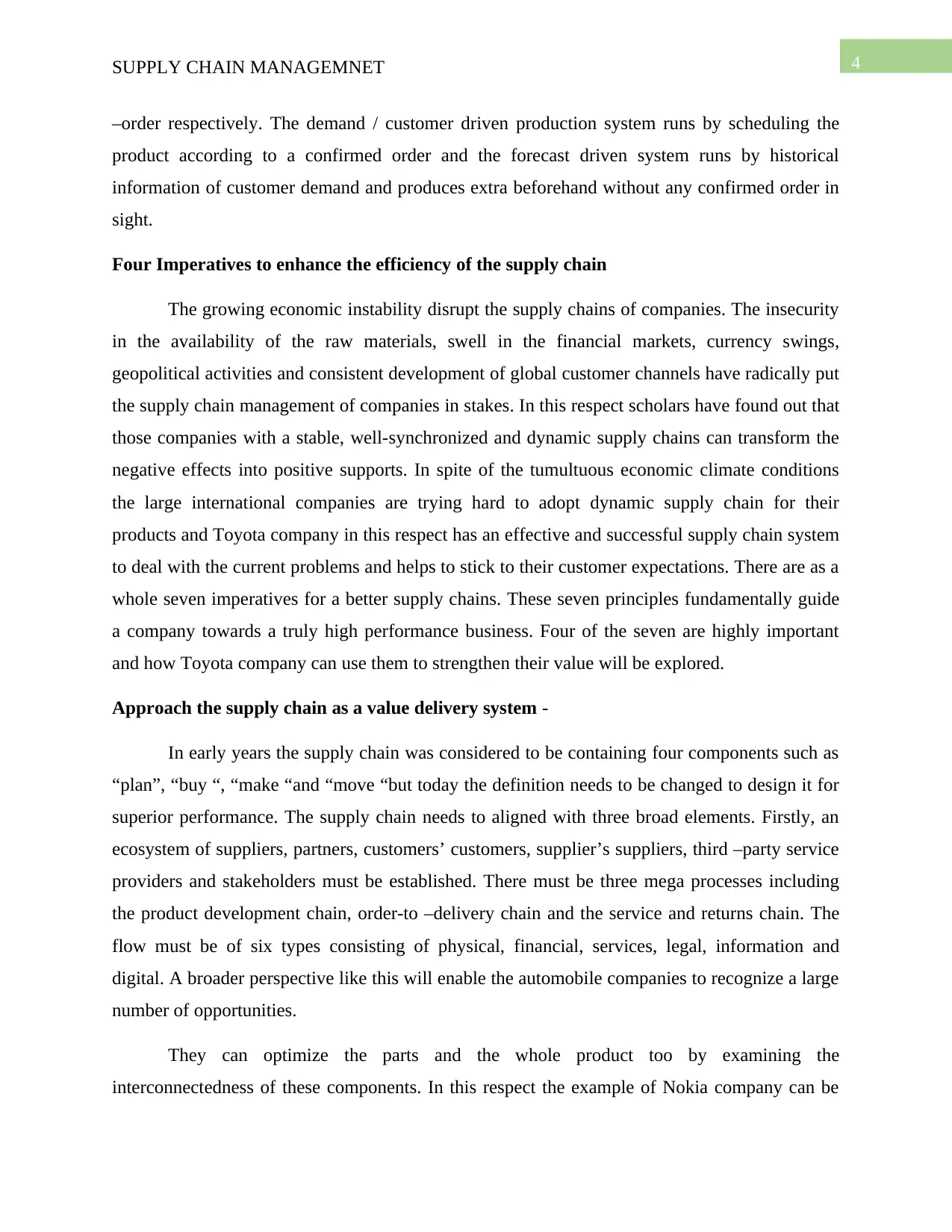
4SUPPLY CHAIN MANAGEMNET
–order respectively. The demand / customer driven production system runs by scheduling the
product according to a confirmed order and the forecast driven system runs by historical
information of customer demand and produces extra beforehand without any confirmed order in
sight.
Four Imperatives to enhance the efficiency of the supply chain
The growing economic instability disrupt the supply chains of companies. The insecurity
in the availability of the raw materials, swell in the financial markets, currency swings,
geopolitical activities and consistent development of global customer channels have radically put
the supply chain management of companies in stakes. In this respect scholars have found out that
those companies with a stable, well-synchronized and dynamic supply chains can transform the
negative effects into positive supports. In spite of the tumultuous economic climate conditions
the large international companies are trying hard to adopt dynamic supply chain for their
products and Toyota company in this respect has an effective and successful supply chain system
to deal with the current problems and helps to stick to their customer expectations. There are as a
whole seven imperatives for a better supply chains. These seven principles fundamentally guide
a company towards a truly high performance business. Four of the seven are highly important
and how Toyota company can use them to strengthen their value will be explored.
Approach the supply chain as a value delivery system -
In early years the supply chain was considered to be containing four components such as
“plan”, “buy “, “make “and “move “but today the definition needs to be changed to design it for
superior performance. The supply chain needs to aligned with three broad elements. Firstly, an
ecosystem of suppliers, partners, customers’ customers, supplier’s suppliers, third –party service
providers and stakeholders must be established. There must be three mega processes including
the product development chain, order-to –delivery chain and the service and returns chain. The
flow must be of six types consisting of physical, financial, services, legal, information and
digital. A broader perspective like this will enable the automobile companies to recognize a large
number of opportunities.
They can optimize the parts and the whole product too by examining the
interconnectedness of these components. In this respect the example of Nokia company can be
–order respectively. The demand / customer driven production system runs by scheduling the
product according to a confirmed order and the forecast driven system runs by historical
information of customer demand and produces extra beforehand without any confirmed order in
sight.
Four Imperatives to enhance the efficiency of the supply chain
The growing economic instability disrupt the supply chains of companies. The insecurity
in the availability of the raw materials, swell in the financial markets, currency swings,
geopolitical activities and consistent development of global customer channels have radically put
the supply chain management of companies in stakes. In this respect scholars have found out that
those companies with a stable, well-synchronized and dynamic supply chains can transform the
negative effects into positive supports. In spite of the tumultuous economic climate conditions
the large international companies are trying hard to adopt dynamic supply chain for their
products and Toyota company in this respect has an effective and successful supply chain system
to deal with the current problems and helps to stick to their customer expectations. There are as a
whole seven imperatives for a better supply chains. These seven principles fundamentally guide
a company towards a truly high performance business. Four of the seven are highly important
and how Toyota company can use them to strengthen their value will be explored.
Approach the supply chain as a value delivery system -
In early years the supply chain was considered to be containing four components such as
“plan”, “buy “, “make “and “move “but today the definition needs to be changed to design it for
superior performance. The supply chain needs to aligned with three broad elements. Firstly, an
ecosystem of suppliers, partners, customers’ customers, supplier’s suppliers, third –party service
providers and stakeholders must be established. There must be three mega processes including
the product development chain, order-to –delivery chain and the service and returns chain. The
flow must be of six types consisting of physical, financial, services, legal, information and
digital. A broader perspective like this will enable the automobile companies to recognize a large
number of opportunities.
They can optimize the parts and the whole product too by examining the
interconnectedness of these components. In this respect the example of Nokia company can be
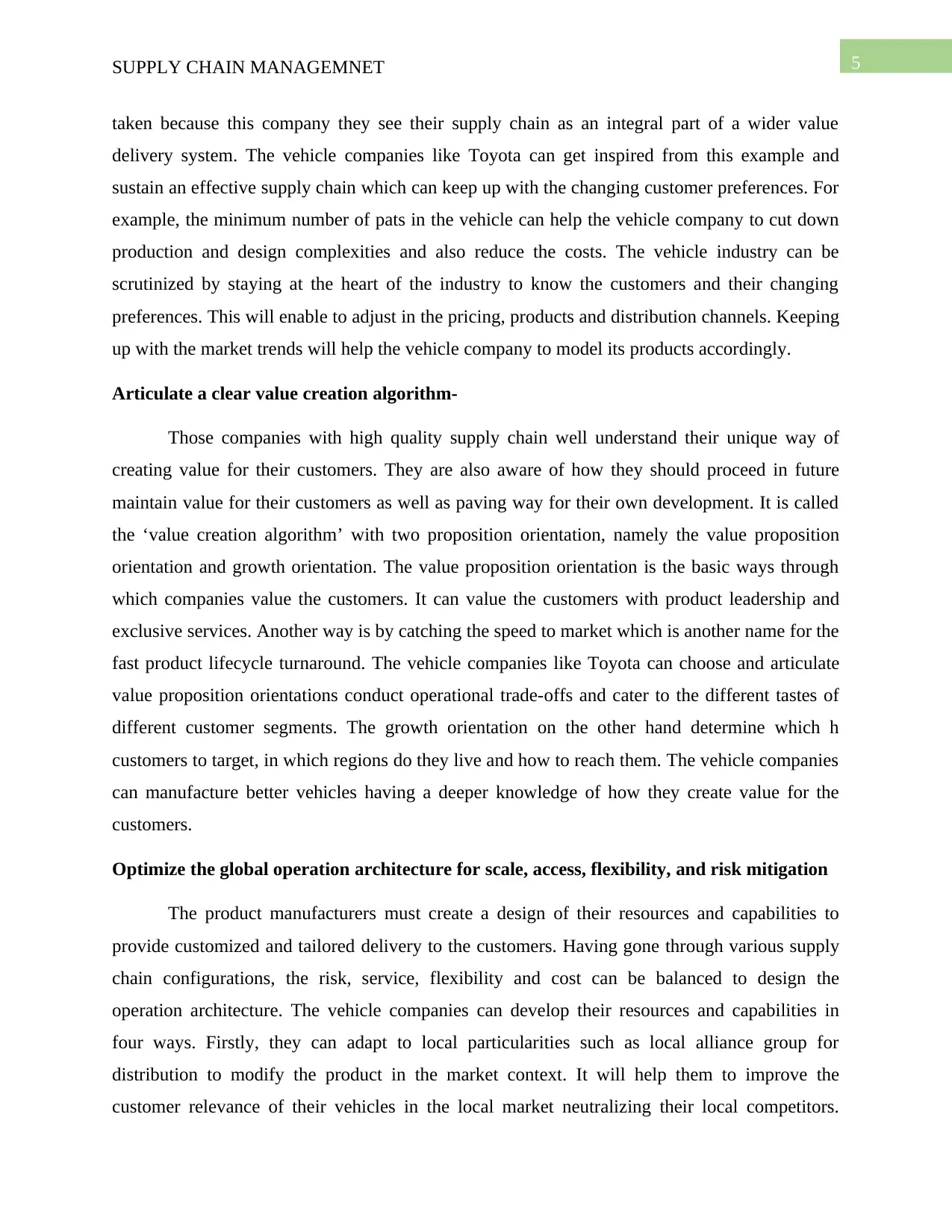
5SUPPLY CHAIN MANAGEMNET
taken because this company they see their supply chain as an integral part of a wider value
delivery system. The vehicle companies like Toyota can get inspired from this example and
sustain an effective supply chain which can keep up with the changing customer preferences. For
example, the minimum number of pats in the vehicle can help the vehicle company to cut down
production and design complexities and also reduce the costs. The vehicle industry can be
scrutinized by staying at the heart of the industry to know the customers and their changing
preferences. This will enable to adjust in the pricing, products and distribution channels. Keeping
up with the market trends will help the vehicle company to model its products accordingly.
Articulate a clear value creation algorithm-
Those companies with high quality supply chain well understand their unique way of
creating value for their customers. They are also aware of how they should proceed in future
maintain value for their customers as well as paving way for their own development. It is called
the ‘value creation algorithm’ with two proposition orientation, namely the value proposition
orientation and growth orientation. The value proposition orientation is the basic ways through
which companies value the customers. It can value the customers with product leadership and
exclusive services. Another way is by catching the speed to market which is another name for the
fast product lifecycle turnaround. The vehicle companies like Toyota can choose and articulate
value proposition orientations conduct operational trade-offs and cater to the different tastes of
different customer segments. The growth orientation on the other hand determine which h
customers to target, in which regions do they live and how to reach them. The vehicle companies
can manufacture better vehicles having a deeper knowledge of how they create value for the
customers.
Optimize the global operation architecture for scale, access, flexibility, and risk mitigation
The product manufacturers must create a design of their resources and capabilities to
provide customized and tailored delivery to the customers. Having gone through various supply
chain configurations, the risk, service, flexibility and cost can be balanced to design the
operation architecture. The vehicle companies can develop their resources and capabilities in
four ways. Firstly, they can adapt to local particularities such as local alliance group for
distribution to modify the product in the market context. It will help them to improve the
customer relevance of their vehicles in the local market neutralizing their local competitors.
taken because this company they see their supply chain as an integral part of a wider value
delivery system. The vehicle companies like Toyota can get inspired from this example and
sustain an effective supply chain which can keep up with the changing customer preferences. For
example, the minimum number of pats in the vehicle can help the vehicle company to cut down
production and design complexities and also reduce the costs. The vehicle industry can be
scrutinized by staying at the heart of the industry to know the customers and their changing
preferences. This will enable to adjust in the pricing, products and distribution channels. Keeping
up with the market trends will help the vehicle company to model its products accordingly.
Articulate a clear value creation algorithm-
Those companies with high quality supply chain well understand their unique way of
creating value for their customers. They are also aware of how they should proceed in future
maintain value for their customers as well as paving way for their own development. It is called
the ‘value creation algorithm’ with two proposition orientation, namely the value proposition
orientation and growth orientation. The value proposition orientation is the basic ways through
which companies value the customers. It can value the customers with product leadership and
exclusive services. Another way is by catching the speed to market which is another name for the
fast product lifecycle turnaround. The vehicle companies like Toyota can choose and articulate
value proposition orientations conduct operational trade-offs and cater to the different tastes of
different customer segments. The growth orientation on the other hand determine which h
customers to target, in which regions do they live and how to reach them. The vehicle companies
can manufacture better vehicles having a deeper knowledge of how they create value for the
customers.
Optimize the global operation architecture for scale, access, flexibility, and risk mitigation
The product manufacturers must create a design of their resources and capabilities to
provide customized and tailored delivery to the customers. Having gone through various supply
chain configurations, the risk, service, flexibility and cost can be balanced to design the
operation architecture. The vehicle companies can develop their resources and capabilities in
four ways. Firstly, they can adapt to local particularities such as local alliance group for
distribution to modify the product in the market context. It will help them to improve the
customer relevance of their vehicles in the local market neutralizing their local competitors.

6SUPPLY CHAIN MANAGEMNET
Secondly they can establish global economies of scale. For example, the vehicle companies do
centralized manufacturing of a particular line of product. It will help them cut down on operating
costs and consolidate their purchasing power. Thirdly they can build he global economies for
scope such as the supply chain analytics center of excellence (Tatoglu, et al.). It will support the
companies sere the global customers in a better way and leverage wider knowledge base. Lastly
they can optimize the configuration of the value chain. For example, they can spread their
manufacturing capabilities worldwide. This imperative will reduce the costs, mitigate risks and
improve the performance.
Segment the supply chain and consistently adapt it to the characteristics of each segment
It should be kept in mind that ala the customers are not equal. Most of the companies try
to treat their customers equally with the ‘one –size –fits –all’ strategy (Dubey et al.).They do not
differentiate between customers but they should understand that every customer will not yield
them equal profit and therefore they should invest with care. First of all, they have to divide their
customers into segments to determine which market do they want to win, also must focus on the
customers ‘customers (Fahimnia, Joseph and Hoda). They must be sensing the demands to
modify their approaches. Next vehicle companies need to profile the demands of their customers
on the parameters of relative lead time, volume and degree of predictability. After this the supply
chain must be aligned with the demand profiles.
Conclusion
Therefore, from the above investigative discussion it can be said that The supply chain
management is a wide range of operations which are necessary to plan, control and execute a
product’s regular flow in the market. The stakeholders, suppliers, manufacturers are also
involved in the undertaking of this complex an expansive management system. The present paper
dealt with the importance of supply chain management in a vehicle company or any other
business firm to increase the level of performance as well as the customers’ satisfaction rates.
The report started by drawing well-constructed supply chain model for the automotive industry
or the vehicles. The paper next demonstrated the essential imperatives that can give a dynamic
touch to the existing supply chain, Companies like Toyota and others must follow these
imperatives.
Secondly they can establish global economies of scale. For example, the vehicle companies do
centralized manufacturing of a particular line of product. It will help them cut down on operating
costs and consolidate their purchasing power. Thirdly they can build he global economies for
scope such as the supply chain analytics center of excellence (Tatoglu, et al.). It will support the
companies sere the global customers in a better way and leverage wider knowledge base. Lastly
they can optimize the configuration of the value chain. For example, they can spread their
manufacturing capabilities worldwide. This imperative will reduce the costs, mitigate risks and
improve the performance.
Segment the supply chain and consistently adapt it to the characteristics of each segment
It should be kept in mind that ala the customers are not equal. Most of the companies try
to treat their customers equally with the ‘one –size –fits –all’ strategy (Dubey et al.).They do not
differentiate between customers but they should understand that every customer will not yield
them equal profit and therefore they should invest with care. First of all, they have to divide their
customers into segments to determine which market do they want to win, also must focus on the
customers ‘customers (Fahimnia, Joseph and Hoda). They must be sensing the demands to
modify their approaches. Next vehicle companies need to profile the demands of their customers
on the parameters of relative lead time, volume and degree of predictability. After this the supply
chain must be aligned with the demand profiles.
Conclusion
Therefore, from the above investigative discussion it can be said that The supply chain
management is a wide range of operations which are necessary to plan, control and execute a
product’s regular flow in the market. The stakeholders, suppliers, manufacturers are also
involved in the undertaking of this complex an expansive management system. The present paper
dealt with the importance of supply chain management in a vehicle company or any other
business firm to increase the level of performance as well as the customers’ satisfaction rates.
The report started by drawing well-constructed supply chain model for the automotive industry
or the vehicles. The paper next demonstrated the essential imperatives that can give a dynamic
touch to the existing supply chain, Companies like Toyota and others must follow these
imperatives.
Paraphrase This Document
Need a fresh take? Get an instant paraphrase of this document with our AI Paraphraser

7SUPPLY CHAIN MANAGEMNET
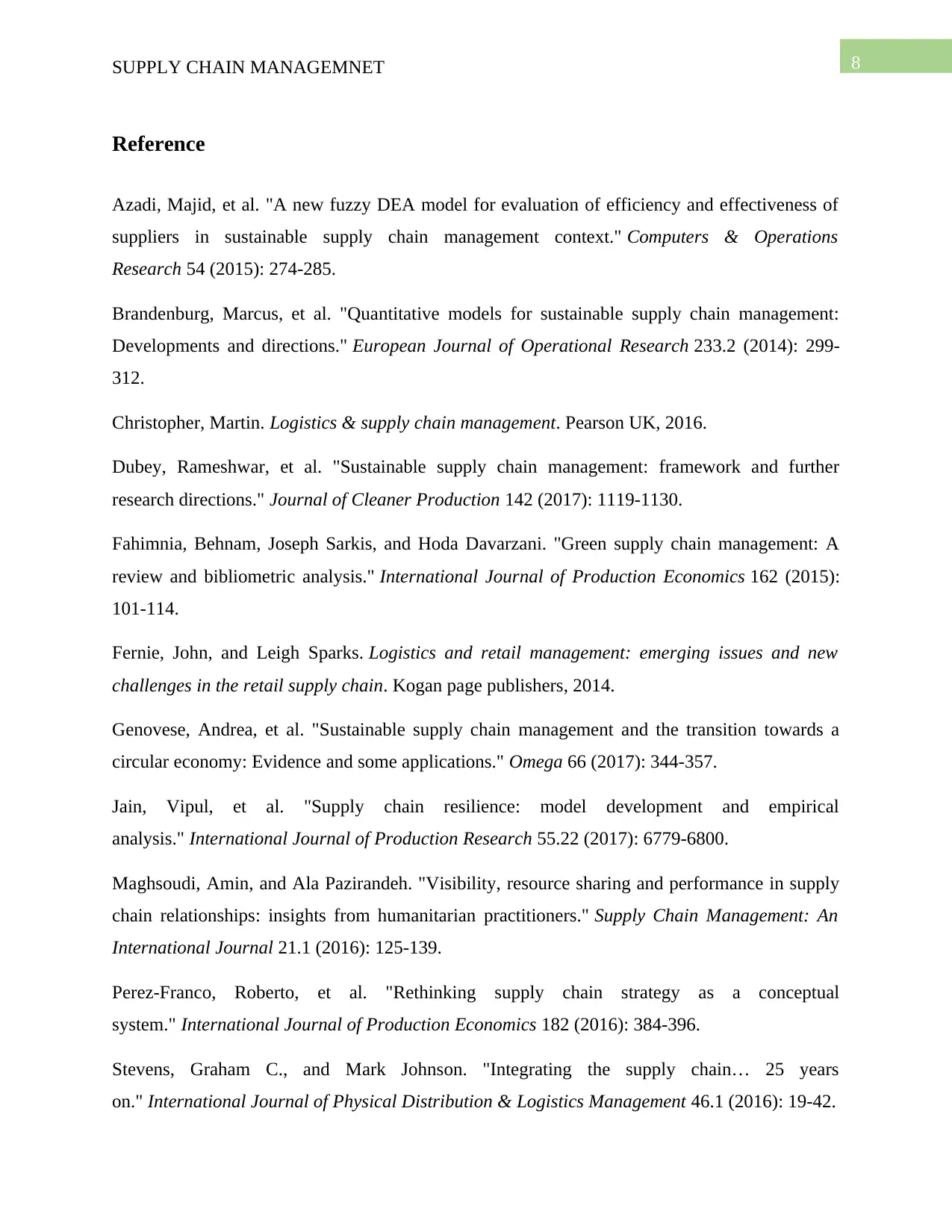
8SUPPLY CHAIN MANAGEMNET
Reference
Azadi, Majid, et al. "A new fuzzy DEA model for evaluation of efficiency and effectiveness of
suppliers in sustainable supply chain management context." Computers & Operations
Research 54 (2015): 274-285.
Brandenburg, Marcus, et al. "Quantitative models for sustainable supply chain management:
Developments and directions." European Journal of Operational Research 233.2 (2014): 299-
312.
Christopher, Martin. Logistics & supply chain management. Pearson UK, 2016.
Dubey, Rameshwar, et al. "Sustainable supply chain management: framework and further
research directions." Journal of Cleaner Production 142 (2017): 1119-1130.
Fahimnia, Behnam, Joseph Sarkis, and Hoda Davarzani. "Green supply chain management: A
review and bibliometric analysis." International Journal of Production Economics 162 (2015):
101-114.
Fernie, John, and Leigh Sparks. Logistics and retail management: emerging issues and new
challenges in the retail supply chain. Kogan page publishers, 2014.
Genovese, Andrea, et al. "Sustainable supply chain management and the transition towards a
circular economy: Evidence and some applications." Omega 66 (2017): 344-357.
Jain, Vipul, et al. "Supply chain resilience: model development and empirical
analysis." International Journal of Production Research 55.22 (2017): 6779-6800.
Maghsoudi, Amin, and Ala Pazirandeh. "Visibility, resource sharing and performance in supply
chain relationships: insights from humanitarian practitioners." Supply Chain Management: An
International Journal 21.1 (2016): 125-139.
Perez-Franco, Roberto, et al. "Rethinking supply chain strategy as a conceptual
system." International Journal of Production Economics 182 (2016): 384-396.
Stevens, Graham C., and Mark Johnson. "Integrating the supply chain… 25 years
on." International Journal of Physical Distribution & Logistics Management 46.1 (2016): 19-42.
Reference
Azadi, Majid, et al. "A new fuzzy DEA model for evaluation of efficiency and effectiveness of
suppliers in sustainable supply chain management context." Computers & Operations
Research 54 (2015): 274-285.
Brandenburg, Marcus, et al. "Quantitative models for sustainable supply chain management:
Developments and directions." European Journal of Operational Research 233.2 (2014): 299-
312.
Christopher, Martin. Logistics & supply chain management. Pearson UK, 2016.
Dubey, Rameshwar, et al. "Sustainable supply chain management: framework and further
research directions." Journal of Cleaner Production 142 (2017): 1119-1130.
Fahimnia, Behnam, Joseph Sarkis, and Hoda Davarzani. "Green supply chain management: A
review and bibliometric analysis." International Journal of Production Economics 162 (2015):
101-114.
Fernie, John, and Leigh Sparks. Logistics and retail management: emerging issues and new
challenges in the retail supply chain. Kogan page publishers, 2014.
Genovese, Andrea, et al. "Sustainable supply chain management and the transition towards a
circular economy: Evidence and some applications." Omega 66 (2017): 344-357.
Jain, Vipul, et al. "Supply chain resilience: model development and empirical
analysis." International Journal of Production Research 55.22 (2017): 6779-6800.
Maghsoudi, Amin, and Ala Pazirandeh. "Visibility, resource sharing and performance in supply
chain relationships: insights from humanitarian practitioners." Supply Chain Management: An
International Journal 21.1 (2016): 125-139.
Perez-Franco, Roberto, et al. "Rethinking supply chain strategy as a conceptual
system." International Journal of Production Economics 182 (2016): 384-396.
Stevens, Graham C., and Mark Johnson. "Integrating the supply chain… 25 years
on." International Journal of Physical Distribution & Logistics Management 46.1 (2016): 19-42.

9SUPPLY CHAIN MANAGEMNET
Tatoglu, Ekrem, et al. "How do supply chain management and information systems practices
influence operational performance? Evidence from emerging country SMEs." International
Journal of Logistics Research and Applications19.3 (2016): 181-199.
Tatoglu, Ekrem, et al. "How do supply chain management and information systems practices
influence operational performance? Evidence from emerging country SMEs." International
Journal of Logistics Research and Applications19.3 (2016): 181-199.
1 out of 10
Related Documents
Your All-in-One AI-Powered Toolkit for Academic Success.
+13062052269
info@desklib.com
Available 24*7 on WhatsApp / Email
![[object Object]](/_next/static/media/star-bottom.7253800d.svg)
Unlock your academic potential
© 2024 | Zucol Services PVT LTD | All rights reserved.





